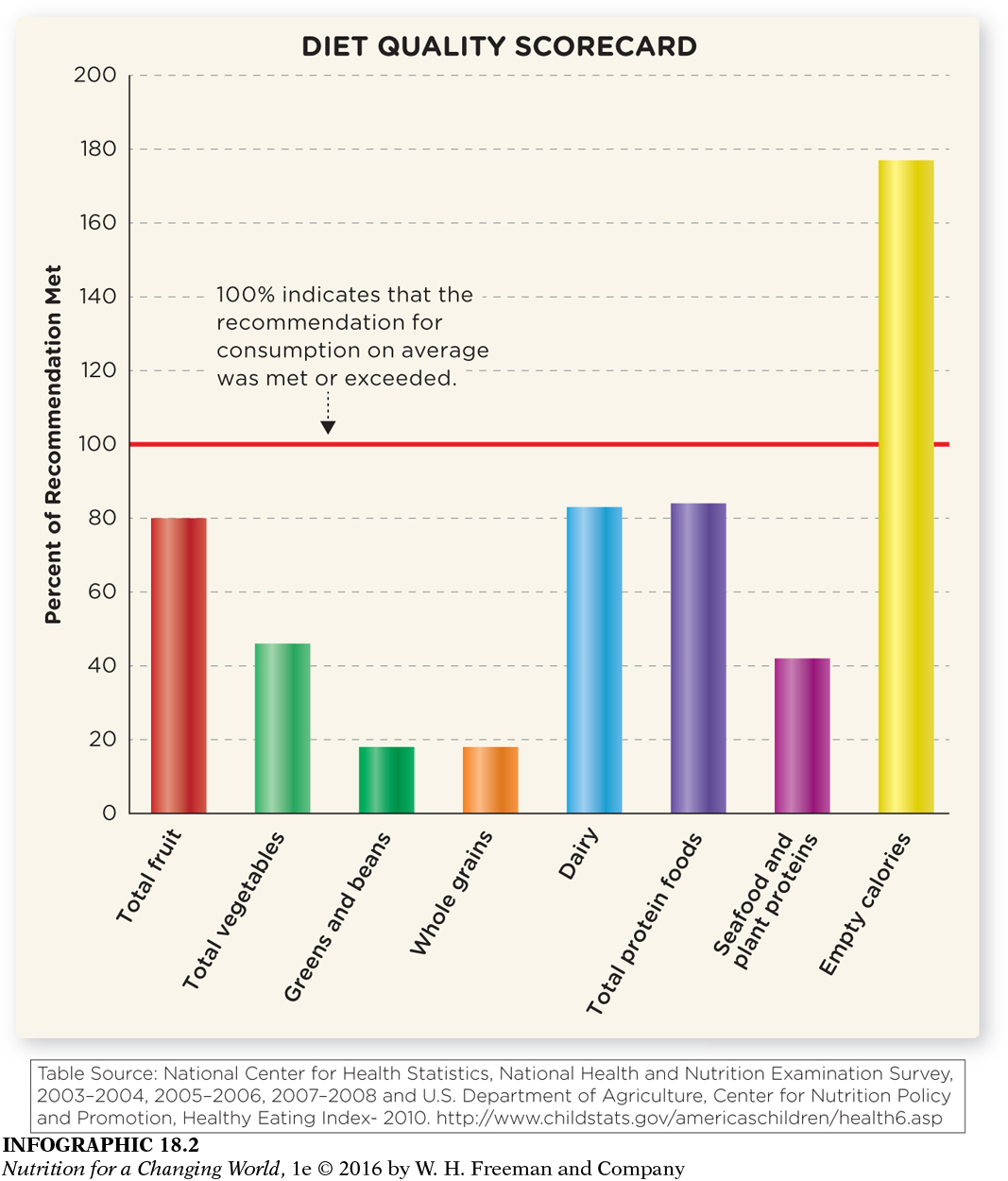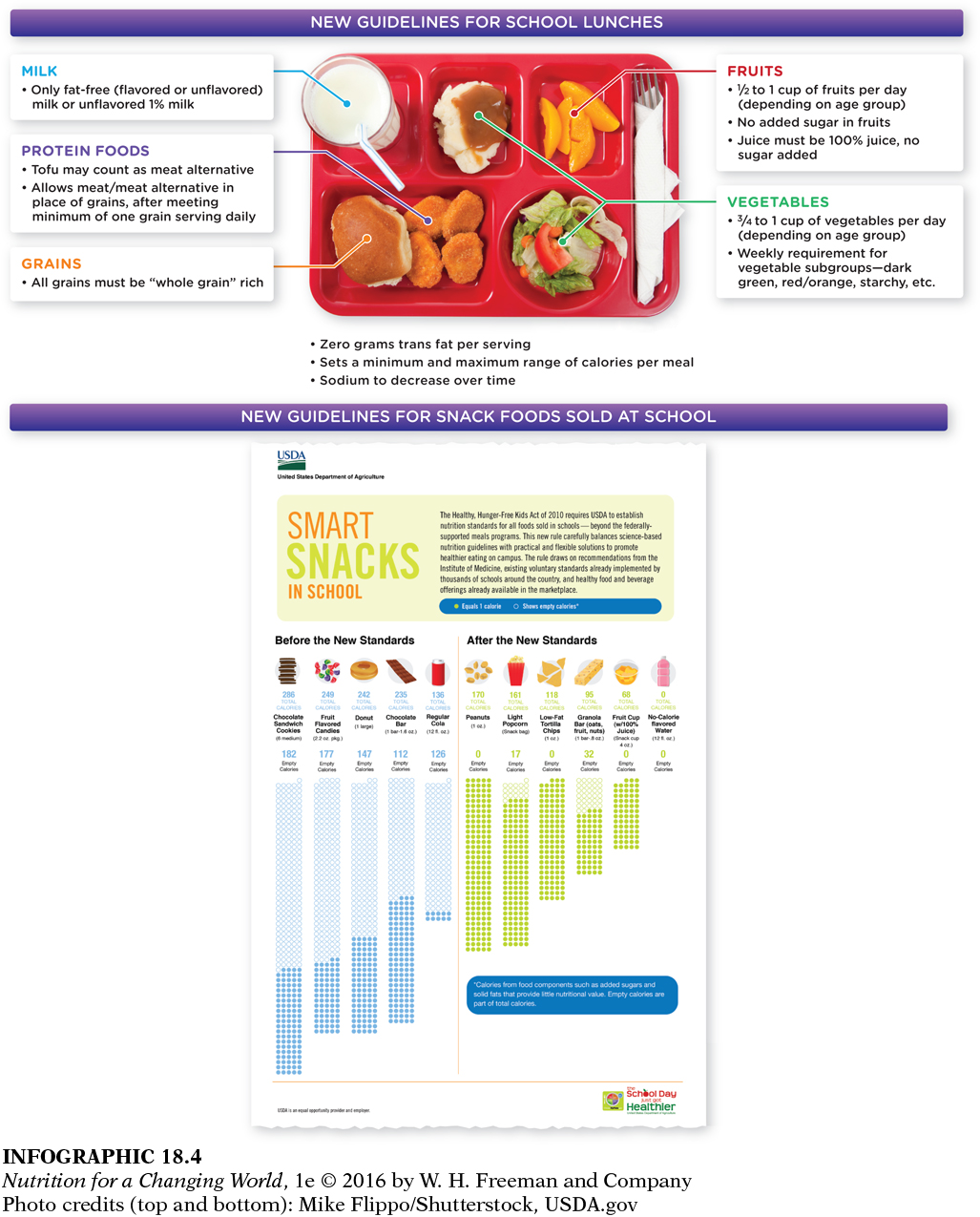WHAT ARE CHILDREN EATING?
Studies suggest that, on average, U.S. children overconsume energy-dense, nutrient-poor foods at the expense of nutrient-dense foods. For instance, up to 90% of children aged 4 to 13 years do not consume the recommended number of servings of fruits and vegetables, and fewer than 20% consume two or more of the recommended servings of whole grains per day. (INFOGRAPHIC 18.2)
INFOGRAPHIC 18.2 How Well Do Children Aged 2 to 17 Years Meet the Recommendations of the Dietary Guidelines for Americans?

Question
18.1
 Did the overall diet quality match up to recommendations? In what areas did it fall short?
Did the overall diet quality match up to recommendations? In what areas did it fall short?
The overall diet quality did not match up to recommendations in any area. It also included an excess of empty calories.
Nutrition surveys have found that children and adolescents between the ages of 2 and 18 years get approximately one-third of the total calories they consume, far exceeding recommended allowances, in the form of empty calories. Solid fats and added sugars, which provide a significant amount of these empty calories, are found in abundance in foods like soda, fruit drinks, grain desserts, pizza, whole milk, and many packaged snacks. (INFOGRAPHIC 18.3)
INFOGRAPHIC 18.3 What Types of Foods Are Children Commonly Eating?

Question
18.2
 What type of milk is not a source of solid fats and added sugars?
What type of milk is not a source of solid fats and added sugars?
Low-fat milk is not a source of solid fats and added sugars.
Why are children eating so poorly? One problem is that kids are now eating more meals away from home, particularly at fast-food restaurants, which tend to serve energy-dense and nutrient-poor foods in large portion sizes. Studies suggest that children who eat the most fast foods have diets with higher total intakes of total energy, saturated fat, and sodium. Children tend to eat less when they can serve themselves, as they might do at home; children eating at home also tend to eat more nutrient-rich foods. Family mealtimes at home can also do a lot to affect nutrition beliefs and attitudes, which typically translates to healthier food choices, reducing kids’ future risk for overweight and obesity.
Beverage consumption has also shifted in children and adolescents in recent decades, which is probably driving weight gain, too. Children aged 2 to 18 years drink less milk than did the same age group in the past but more soft drinks. On average, children consume close to 10% of their total calorie intake from sugar-sweetened beverages, and half of all Americans, including kids, consume sugar drinks on any given day. This high sugar consumption could be a primary reason that a whopping 42% of children aged 2 to 11 years have had dental caries in their primary teeth.
NATIONAL SCHOOL LUNCH PROGRAM federally assisted school meal program that provides nutritionally balanced, low-cost (or free) lunches to children each school day
One piece of good news, however, is that more and more children—30 million kids in 2013—are participating in the National School Lunch Program, a federally assisted meal program operating in public and nonprofit private schools and residential child care institutions that provides nutritionally balanced, low-cost (or free) lunches to children each school day. In January 2012, in part as a result of the 2010 passage of the Healthy, Hunger-Free Kids Act, the USDA issued new standards—the first major update to these school meals in 15 years—that increase the number of fruits and vegetables included in these meals, emphasize whole grain–rich foods, serve only low-fat and nonfat milk, limit calories, and reduce saturated fat and sodium content to ensure that the meals are in line with the U.S. Dietary Guidelines for Americans. (INFOGRAPHIC 18.4)
INFOGRAPHIC 18.4 Foods at School and the Healthy, Hunger-Free Kids Act New nutrition standards affecting lunches and snacks sold during the school day are aimed at ensuring that kids are being fed healthy foods while they are at school.

USDA.gov

Children who eat at home typically eat more nutrient-rich food than those who eat at restaurants.

 Did the overall diet quality match up to recommendations? In what areas did it fall short?
Did the overall diet quality match up to recommendations? In what areas did it fall short?
 What type of milk is not a source of solid fats and added sugars?
What type of milk is not a source of solid fats and added sugars?
